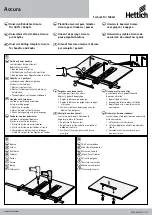
27
OPERATION MANUAL
TROUBLESHOOTING
Read the troubleshooting section if a problem develops with your machine. If you need any
assistance or additional help with a problem, call the Technical Support Department. For
spare parts go to
www.machineryhouse.com.au/contactus
and fill out the enquiry form atta-
ching a copy of scanned parts list.
Symptom
Possible Cause
Possible Solution
Machine does not
start or a breaker
trips.
1. Plug/receptacle at fault/wired wrong.
2. Incorrect power supply voltage/circuit size.
3. Power supply circuit breaker tripped or fuse
blown.
4. Motor wires connected incorrectly.
5. Wiring open/has high resistance.
6. Spindle rotation switch at fault.
7. Start capacitor at fault .
8. Centrifugal switch at fault .
9. Motor at fault.
1. Test for good contacts; correct the wiring.
2. Ensure correct power supply voltage/circuit size.
3. Ensure circuit is sized correctly and free of shorts.
Reset circuit breaker or replace fuse.
4. Correct motor wiring connections.
5. Check/fix broken, disconnected, or corroded wires.
6. Replace switch.
7. Test/replace.
8. Adjust/replace centrifugal switch if available.
9. Test/repair/replace.
Machine stalls or is
underpowered
1. Machine undersized for task.
2. Feed rate/cutting speed too fast.
3. Wrong workpiece material.
4. Belt(s) slipping.
5. Oil/grease on belt(s).
6. Motor wired incorrectly.
7. Spindle rotation switch at fault.
8. Gearbox at fault.
9. Motor overheated.
10. Pulley/sprocket slipping on shaft.
11. Centrifugal switch at fault.
12. Motor bearings at fault.
1. Use correct cutter/bit; reduce feed rate; reduce
spindle RPM; use coolant if possible.
2. Decrease feed rate/cutting speed.
3. Use correct type/size of metal.
4. Tension/replace belt(s); ensure pulleys are aligned.
5. Clean belt(s).
6. Wire motor correctly.
7. Test/replace switch.
8. Select appropriate gear ratio; replace broken or
slipping gears.
9. Clean motor, let cool, and reduce workload.
10. Replace loose pulley/shaft.
11. Adjust/replace centrifugal switch if available.
12. Test/repair/replace.
Machine has
vibration or noisy
operation.
1. Workpiece loose.
2. Belt(s) worn or loose.
3. Motor or component loose.
4. Chuck or cutter at fault.
5. Belt(s) slapping headstock casting/guard.
6. Motor fan rubbing on fan cover.
7. Pulley loose.
8. Machine incorrectly mounted.
9. Motor bearings at fault.
10. Centrifugal switch is at fault .
1. Use the correct holding fixture/reclamp workpiece.
2. Inspect/replace belts with a new matched set.
3. Inspect/replace damaged bolts/nuts, and retighten
with thread locking fluid.
4. Replace unbalanced chuck; replace/resharpen
cutter; use correct feed rate.
5. Replace/realign belts with a matched set.
6. Fix/replace fan cover; replace loose/damaged fan.
7. Re-align/replace shaft, pulley set screw, and key.
8. Tighten mounting bolts; relocate/shim machine.
9. Test by rotating shaft; rotational grinding/loose
shaft requires bearing replacement.
10. Replace
Page 27
Instructions Manual for BM-23A (M595D)
12/02/2018
















































